Grid connection
Interconnection queues: Why grid connection is getting harder and how to respond
Market insights
May 20, 2025
5 min read
Delays, dropouts, and rising demands – why getting a grid connection is tougher than ever, and what it takes to make it through the interconnection queue.
Across global energy markets, the interconnection queue has become one of the biggest bottlenecks to clean energy deployment. Projects are piling up faster than the grid can evolve, creating delays, competition, and uncertainty for developers.
Before you submit your application, it’s worth understanding why the queue is so long, what’s being done to fix it, and what you can do to stay ahead.
Why is the interconnection queue so long?
The short answer is: Demand is growing faster than the grid can handle.
Global renewable energy deployment continues to rise, but the infrastructure needed to connect these projects to the grid hasn’t kept pace. According to the International Energy Agency’s ‘Renewables 2024’ analysis, by mid-2024, over 1,650 GW of solar, wind, and hydropower capacity was in advanced development stages and still waiting for grid connection.

Most of this capacity comes from solar PV, which now makes up more than 60% of the interconnection queue. Wind accounts for just over 35%, with hydropower trailing far behind. As more developers try to connect their projects, the grid quickly becomes overwhelmed. This is especially since many system operators still rely on traditional, sequential approval models.
To complicate matters further, some projects trigger the need for major grid upgrades. This adds cost and delay to the process.
What is an interconnection queue?
An interconnection queue is the list of energy projects waiting to be connected to the power grid. When a developer wants to add a new project – whether it’s solar, wind, battery storage, or a hybrid setup – they must apply for grid connection. That application enters a queue managed by the local transmission system operator or grid authority.
Projects are typically processed in the order they enter the queue. However, technical readiness, regulatory changes, and grid capacity can all affect how long the wait lasts – and whether a project gets approved at all.
What is causing ‘zombie projects’ in the interconnection queue?
To avoid getting stuck in a long queue later, developers often apply for grid connection very early, sometimes before finalizing financing, permits, or designs. While this might seem like smart planning, it leads to a major downside.
Many of these early-stage projects never move forward. They get stuck due to a lack of financing, missing permits, or unclear feasibility. These inactive or low-probability projects, often called zombie projects, stay in the queue, blocking progress for shovel-ready ones.
As our colleague, Paul Manning from Novogrid, mentions in the video below:
“It’s all about the queue being overloaded. There are too many people in the queue, too many projects that will never connect – we call these ‘zombie projects’.”
As a result, the queue becomes clogged with inactive entries, creating further delays and adding pressure to an already overloaded system.
Countries introduce reforms to improve the interconnection queue
To clear the backlog and create a more efficient system, many countries are reforming how interconnection queues are managed. The main goal is to prioritize serious, shovel-ready projects and make it easier to remove those that are stalled or speculative.
The UK’s Connection Action Plan, which Paul also mentions in the video above, is one example. It raises entry requirements and introduces clear construction milestones. If a project fails to hit those milestones, it can be removed, freeing up space for others. Additionally, developers are also allowed to exit the queue voluntarily without penalties, which could lead to up to 8 GW in withdrawn projects.
Similar reforms are emerging in other markets as well. In the US, for example, FERC Order 2023 introduces rules for more structured interconnection studies and a shift toward a “first-ready, first-served” approach.
The grid reforms create challenges and place greater demands on you
Queue reforms are improving efficiency, but they also raise the bar. With stricter entry requirements and tougher competition, you will be competing in a leaner but higher-quality queue.
“Once that queue is flushed, then what we will have is a higher-quality queue,” explains Paul Manning from Novogrid. In other words: fewer projects, but stronger competitors. That means your project needs to be fully prepared from the outset.
Speed is also becoming a critical factor. Success will depend on how quickly you can submit a strong application, respond to offers, and act on updated queue positions. A few hours’ delay can be the difference between getting ahead and getting stuck behind.
Grid connection studies can get you over the line
For large and complex projects, including solar, BESS, or hybrid systems, it’s critical to demonstrate grid compliance. This usually requires detailed grid studies or simulations to show how your plant will behave once connected. These studies require specialized expertise, and not many players in the market can deliver this across solar, storage, and hybrid setups.
Fortunately, Opoura’s power engineering team can, together with Paul and the rest of our colleagues at Novogrid help you prepare, analyze, and act – so you don’t lose momentum when the next window of opportunity opens.
